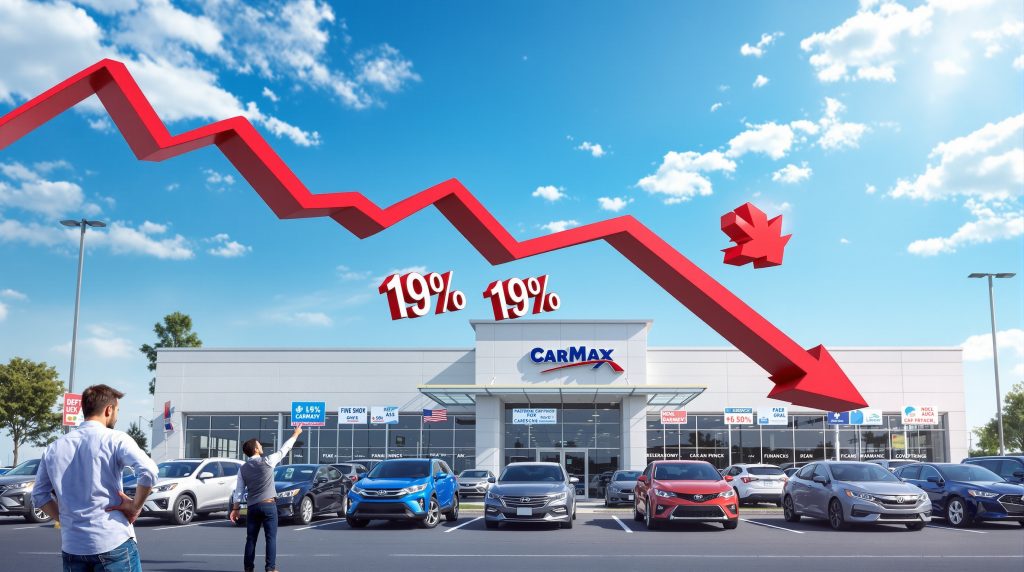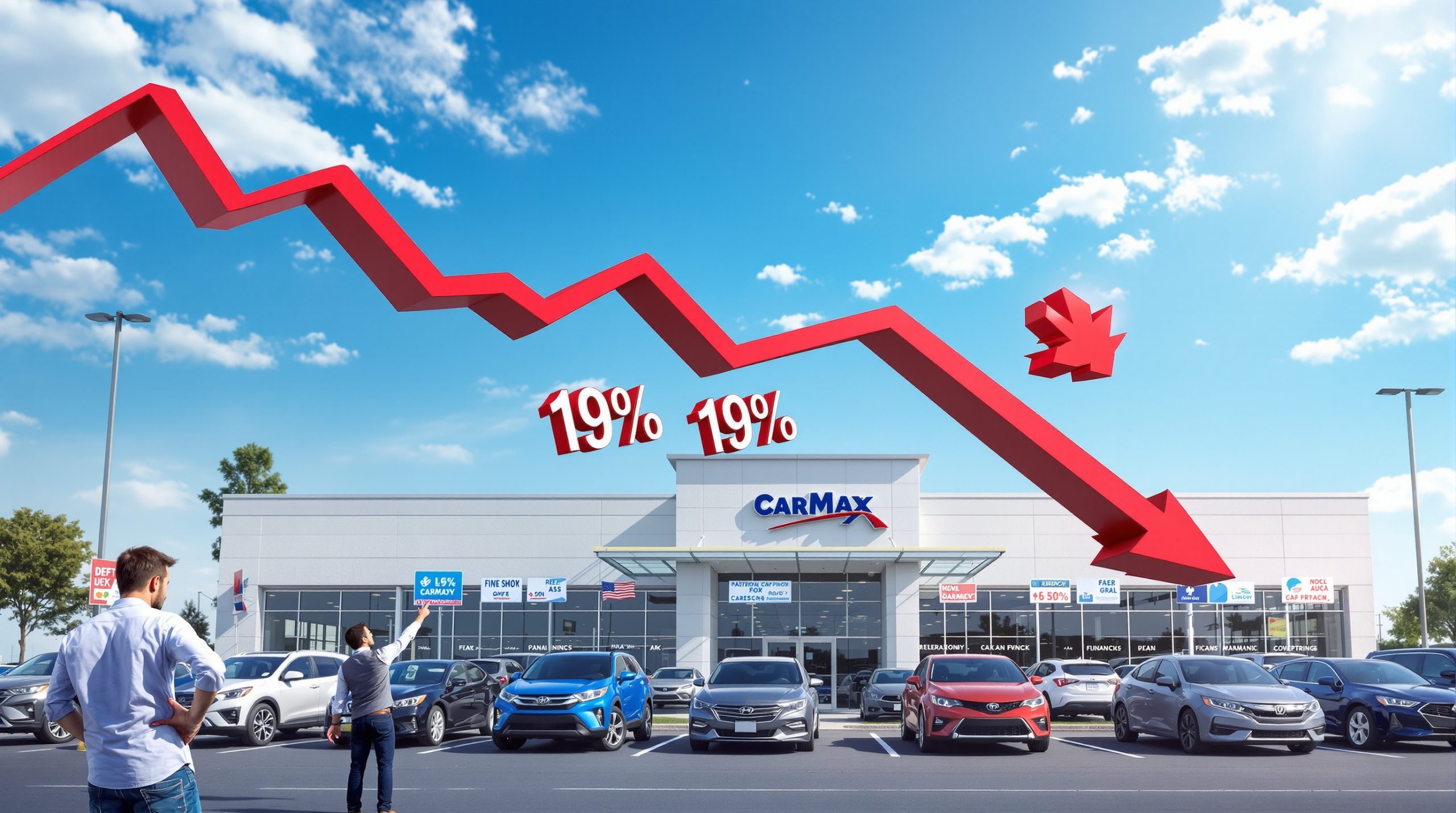Why Did CarMax Shares Drop 19% in a Single Day?
CarMax stock experienced a dramatic 19% plunge following the release of its fiscal second quarter 2025 results on September 25, 2025. This severe market reaction underscores the magnitude of the company's underperformance relative to Wall Street expectations and highlights growing concerns about the used vehicle retailer's near-term prospects amid ongoing US economic pressures.
The Numbers Behind the Sell-Off
The financial details paint a troubling picture of CarMax's performance:
- Earnings per share came in at just $0.64, representing a staggering 38.5% miss compared to the $1.04 analyst consensus
- Revenue reached only $6.59 billion, falling $420 million short of the expected $7.01 billion
- Retail used vehicle sales declined by 5.4% year-over-year, indicating deteriorating consumer demand
- Gross profit margins contracted significantly due to increased competitive pressures
This combination of missed targets across multiple metrics triggered one of the most significant single-day stock declines in CarMax's recent history, erasing billions in market capitalization.
Market Context Driving Disappointment
The disappointing CarMax quarterly results didn't occur in isolation. Several market factors contributed to CarMax's challenging quarter:
- Rising interest rates have increased monthly payment amounts, reducing affordability for many potential buyers
- Consumer sentiment about large purchases has weakened amid persistent inflation concerns
- The used vehicle market continues to normalize following the pandemic-driven price surges of 2021-2022
- Competition among used vehicle retailers has intensified as inventory levels have normalized
Industry analysts note that CarMax's results may signal broader troubles across the used vehicle sector, rather than company-specific operational issues.
How Does This Compare to CarMax's Historical Performance?
The second quarter results represent a notable departure from CarMax's typical performance trajectory, particularly following the exceptional profits realized during the pandemic's supply chain disruptions.
Historical Context and Cyclical Patterns
CarMax has generally demonstrated resilience through automotive retail cycles, but the current results diverge from historical norms:
- The 38.5% earnings miss ranks among the company's largest quarterly disappointments in the past decade
- Same-store sales have now declined for multiple consecutive quarters, breaking previous recovery patterns
- Average selling prices continue to normalize downward from their 2022 peaks
- Gross profit per retail unit has contracted significantly compared to pandemic-era margins
This performance suggests CarMax is struggling with the transition from the artificially constrained supply environment of 2021-2022 back to more normalized market conditions, a trend further complicated by global recession concerns.
Operational Metrics Showing Weakness
Beyond the headline financial figures, operational metrics reveal additional concerns:
- Conversion rates (the percentage of shoppers completing purchases) have declined, indicating consumer hesitation
- Inventory turnover has slowed, resulting in higher carrying costs
- Wholesale auction volumes have decreased, affecting this secondary revenue stream
- The average time vehicles spend on lots before selling has increased substantially
These operational challenges collectively point to a company working through a difficult market adjustment phase rather than facing a fundamental business model crisis.
What Industry Challenges Are Affecting Used Car Retailers?
The broader used vehicle market faces a complex set of challenges that extend well beyond CarMax's individual performance issues.
Macroeconomic Headwinds
Several economic factors have converged to create a difficult environment:
- Interest rates remain elevated compared to historical norms, directly impacting financing costs for consumers
- The average used vehicle loan now extends beyond 70 months, approaching the limit of consumer affordability
- Inflation has eroded purchasing power, forcing many households to delay vehicle purchases
- The gap between average incomes and vehicle prices remains stubbornly wide despite recent price corrections
Banking industry data indicates approval rates for auto loans have decreased approximately 12% compared to pre-pandemic levels, further constraining the potential buyer pool. Additionally, US–China trade effects continue to influence parts availability and costs.
Supply Chain and Inventory Dynamics
The used vehicle supply chain continues to experience unique challenges:
- The pipeline of 3-5 year old vehicles (typically the sweet spot for used inventory) remains constrained due to production limitations during pandemic years
- Reconditioning costs have increased due to parts availability issues and labor costs
- New vehicle production has recovered but remains below pre-pandemic levels, affecting the future used supply
- Transportation costs for moving vehicles between markets remain elevated
Market analysts note that these inventory challenges may persist through 2026 as the production shortfalls from 2020-2022 continue to affect the availability of prime-age used vehicles.
How Is CarMax Responding to These Challenges?
Despite the disappointing quarter, CarMax management has outlined several strategic initiatives designed to navigate the current market difficulties and position the company for recovery.
Strategic Adjustments and Operational Changes
The company is implementing multiple operational changes:
- More selective vehicle purchasing to optimize inventory mix and minimize exposure to declining segments
- Regional inventory redistribution to better match local market demand patterns
- Enhanced pricing algorithms that incorporate real-time competitor data and local market conditions
- Cost reduction measures targeting approximately $100 million in annualized savings
These operational adjustments aim to preserve margins while maintaining competitive positioning during this challenging phase.
Digital and Customer Experience Investments
CarMax continues to invest in its omnichannel retail strategy:
- Enhanced mobile application functionality to improve the digital shopping experience
- Streamlined financing application processes to reduce friction in the purchasing journey
- Expansion of home delivery options to additional markets
- Integration of augmented reality features for virtual vehicle inspections
Industry experts note that these digital investments may provide CarMax with competitive advantages once market conditions improve, as online and hybrid purchasing pathways continue gaining popularity among consumers.
What Do Financial Analysts Predict for CarMax's Future?
Wall Street's reaction to CarMax's disappointing results has been measured but cautious, with varying perspectives on recovery timelines.
Revised Outlook and Recovery Timeline
Financial analysts have adjusted their expectations following the earnings miss:
- Most project continued challenges through at least the next two quarters
- Consensus estimates for fiscal 2026 have been reduced by approximately 15-20%
- Recovery timelines vary from 6-18 months depending on macroeconomic assumptions
- Price targets have been adjusted downward by an average of 22% across major investment firms
The variation in recovery projections reflects uncertainty about both broader economic conditions and CarMax's ability to adapt its operations to the changing market environment. Some analysts point to the tariffs impact on investments as a continued headwind for consumer discretionary purchases.
Key Performance Indicators to Monitor
Analysts highlight several metrics as particularly important for gauging CarMax's recovery progress:
- Gross profit per unit trends, which serve as a leading indicator of pricing power
- Inventory turnover rates, which reflect both purchasing discipline and market demand
- SG&A expenses as a percentage of gross profit, measuring operational efficiency
- Free cash flow generation, indicating financial flexibility during the downturn
Market observers note that improvement in these metrics could precede a stock recovery, even before headline revenue and earnings figures fully rebound.
How Does CarMax Compare to Other Used Vehicle Retailers?
The challenging quarter raises questions about whether CarMax's difficulties represent company-specific issues or broader industry trends.
Competitive Positioning Assessment
Comparisons with competitors reveal a mixed picture:
- Traditional dealership groups have reported similar pressure on used vehicle operations but have new vehicle sales as a buffer
- Online-only retailers like Carvana and Vroom have experienced even greater margin compression
- Wholesale auction companies have maintained more stable profitability despite volume declines
- Private seller transactions have increased as consumers seek to avoid dealer premiums
This competitive landscape suggests CarMax's challenges are predominantly industry-related rather than execution failures, though some competitors have demonstrated more resilient performance. According to recent analysis from Seeking Alpha, CarMax's quarter was "ugly" but reflected sector-wide challenges.
Relative Strengths and Vulnerabilities
CarMax maintains several competitive advantages despite current challenges:
- Scale efficiencies in purchasing, reconditioning, and logistics remain industry-leading
- Brand recognition and consumer trust metrics outperform most competitors
- Financial position remains stronger than many pure-play online competitors
- Omnichannel capabilities bridge traditional and digital retail approaches effectively
However, the company faces unique challenges due to its business model:
- Larger physical footprint creates higher fixed cost exposure during downturns
- Price transparency model limits pricing flexibility compared to traditional dealerships
- Wholesale auction business faces margin pressure in softer markets
- Premium brand positioning may limit appeal during periods of heightened price sensitivity
These dynamics create a complex competitive picture with both advantages and vulnerabilities for CarMax's recovery prospects.
What Are the Long-Term Implications for CarMax's Business Model?
The challenging quarter has prompted discussion about potential evolutionary changes to CarMax's business model beyond simply weathering the current market conditions.
Business Model Evolution Possibilities
Several potential adaptations could emerge:
- Greater adoption of consignment and marketplace models to reduce inventory risk
- Expanded service and maintenance offerings to diversify revenue streams
- Enhanced financial services integration beyond current loan origination activities
- Development of subscription or flexible ownership options to address changing consumer preferences
Industry experts suggest these adaptations would represent evolutions rather than revolutionary changes to CarMax's core value proposition of transparent, no-haggle used vehicle sales.
Industry Transformation Considerations
Broader automotive retail trends will influence CarMax's long-term trajectory:
- The transition toward electric vehicles will require adjustments to reconditioning operations and valuation models
- Autonomous vehicle technologies may eventually impact ownership patterns and retail models
- Shifting demographic preferences regarding vehicle ownership versus mobility services
- Regulatory changes affecting vehicle emissions and fuel economy standards
CarMax's ability to navigate these transformational factors will significantly influence its competitive position over the next decade, particularly as trump tariffs market impact continues to shape the broader automotive industry.
What Can Investors Learn from CarMax's Earnings Miss?
The significant stock decline following CarMax's earnings report provides several valuable lessons for investors in cyclical retail businesses.
Investment Insights
Prudent investors can extract several key lessons:
- Cyclical businesses require valuation frameworks that account for earnings volatility through market cycles
- Inventory-heavy retail models face unique risks during market transitions
- Consumer financing availability can dramatically impact big-ticket discretionary purchases
- Digital transformation investments may temporarily pressure margins before delivering returns
Understanding these dynamics can help investors better anticipate potential challenges in similar consumer discretionary sectors. As Finimize reports, CarMax's situation provides important insights into the broader consumer spending environment.
Valuation Framework Considerations
The market's reaction suggests a recalibration of appropriate valuation metrics:
- Price-to-earnings multiples have compressed significantly from their pandemic-era peaks
- Free cash flow yield has become a more prominent valuation metric than earnings during this period
- Balance sheet strength and liquidity reserves have gained importance in investor assessments
- Recovery timeline expectations have been extended, affecting discounted cash flow models
These valuation adjustments reflect a more cautious assessment of the used vehicle retail sector's near-term prospects while acknowledging the potential for eventual recovery.
FAQ About CarMax's Quarterly Performance
Why did CarMax stock fall so dramatically after earnings?
The 19% decline reflected multiple concerns: the significant magnitude of the earnings miss (38.5% below expectations), revenue shortfall ($420 million below forecast), declining retail vehicle sales volume, and compressed profit margins. The combination of these factors raised questions about both the current operating environment and the timeline for potential recovery, prompting investors to significantly reduce their valuation expectations.
Is this primarily a CarMax-specific problem or an industry-wide issue?
Evidence suggests this is predominantly an industry-wide challenge rather than a CarMax execution failure. Multiple factors affecting the entire used vehicle market are at play, including interest rate pressures, normalization of prices from pandemic peaks, and changing consumer spending patterns. However, CarMax's size and business model create unique exposures to these industry trends compared to diversified dealership groups.
How does the current used car market compare to historical patterns?
The current market represents a normalization from the extraordinary conditions of 2021-2022, when supply chain disruptions created artificial scarcity and drove prices to unprecedented levels. This correction phase has proven more challenging than many anticipated due to the combined effects of higher interest rates, persistent inflation, and shifting consumer priorities. Historical data suggests such adjustment periods typically last 4-8 quarters before reaching a new equilibrium.
What key indicators should investors watch for signs of CarMax's recovery?
Investors should monitor several leading indicators: gross profit per unit trends (for margin stabilization), inventory turnover rates (for purchasing discipline), SG&A as a percentage of gross profit (for operational efficiency), and free cash flow generation (for financial flexibility). Improvement in these operational metrics would likely precede a recovery in headline financial results and stock performance.
Further Exploration:
Readers interested in learning more about trends in the used vehicle market and automotive retail sector can explore additional educational content about automotive industry developments, consumer financing trends, and shifts in transportation preferences. Understanding these broader contexts provides valuable perspective on CarMax's current challenges and future opportunities in the evolving automotive retail landscape.
Ready to Spot the Next Market-Moving Discovery?
Discover significant ASX mineral findings before the broader market with Discovery Alert's proprietary Discovery IQ model, providing real-time alerts and actionable insights for both short-term traders and long-term investors. Explore why major mineral discoveries lead to substantial returns by visiting our dedicated discoveries page and begin your 30-day free trial today.




